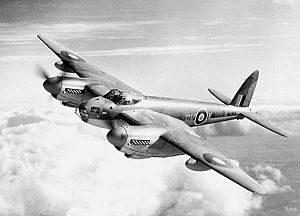Quote of the Day
"In 1940 I could at least fly as far as Glasgow in most of my aircraft, but not now! It makes me furious when I see the Mosquito. I turn green and yellow with envy. The British, who can afford aluminium better than we can, knock together a beautiful wooden aircraft that every piano factory over there is building, and they give it a speed which they have now increased yet again. What do you make of that? There is nothing the British do not have. They have the geniuses and we have the nincompoops. After the war is over I'm going to buy a British radio set - then at least I'll own something that has always worked."
– Hermann Göring, 1943.Yes - you have that right. This is the most famous German fighter ace of WWII complaining about how British engineering is better than German engineering. The plane in question? (And something of an unsung hero next to the workhorse Hurricane and sexiest-plane-that-ever-flew Spitfire)
The
de Havilland Mosquito
| DH.98 Mosquito | |
|---|---|
| The Mosquito B.Mk XVI ML963 - this aircraft was lost on an operation to Berlin in April 1945 | |
| Role | Fast bomber fighter-bomber night fighter maritime strike fast photo reconnaissance aircraft |
| Manufacturer | de Havilland Aircraft Company |
| First flight | 25 November 1940[1] |
| Introduction | 1941 |
| Status | retired |
| Primary users | Royal Air Force Royal Canadian Air Force Royal Australian Air Force United States Army Air Forces |
| Produced | 1940–1950 |
| Number built | 7,781.[2] |
The de Havilland DH.98 Mosquito was a British combat aircraft that excelled in versatility during the Second World War. It was known affectionately as the "Mossie" to its crews[3] and was also nicknamed "The Wooden Wonder" or "The Timber Terror" as the bulk of the aircraft was made of laminated plywood.[4] It saw service with the Royal Air Force (RAF) and many other air forces in the European theatre, the Pacific theatre of Operations and the Mediterranean Theatre, as well as postwar.
Originally conceived as an unarmed fast bomber, the Mosquito was adapted to many other roles during the air war, including: low to medium altitude daytime tactical bomber, high altitude night bomber, pathfinder, day or night fighter, fighter-bomber, intruder, maritime strike, and fast photo reconnaissance aircraft carrying out aerial reconnaissance. It was even used by the British Overseas Airways Corporation (BOAC) as a transport. It was also the basis for a single-seat heavy fighter, the de Havilland Hornet.
Upon the Air Ministry's decision to enter the Mosquito into production in 1941, it was the fastest operational aircraft in the world.[5] Entering widespread service in 1942, the Mosquito supported RAF strategic night fighter defence forces in the United Kingdom from Luftwaffe raids, most notably defeating the German aerial offensive Operation Steinbock in 1944. Offensively, the Mosquito units also conducted night time fighter sweeps in indirect and direct protection of RAF Bomber Command's bomber fleets to reduce RAF bomber losses in 1944 and 1945. The Mosquito increased German night fighter losses to such an extent the Germans were said to have awarded two victories for shooting one down.[6] As a bomber it took part in "special raids", such as pinpoint attacks on prisoner-of-war camp, Gestapo or German intelligence and security force bases as well as tactical strikes in support of the British Army in the Normandy Campaign. Some Mosquitos also saw action in RAF Coastal Command during the Battle of the Atlantic, attacking Kriegsmarine U-Boat and transport ship concentrations, particularly in the Bay of Biscay offensive in 1943 in which significant numbers of U-Boats were sunk or damaged.
Read on if you wish

Comments
Post a Comment